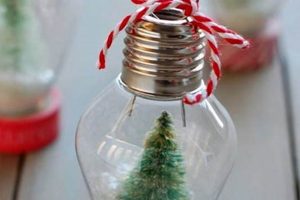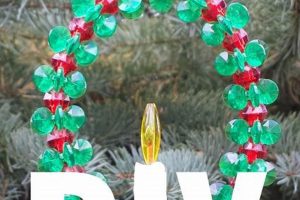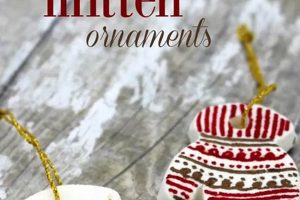The crafting of personalized tributes for remembrance offers a tangible way to honor the memory of loved ones. These handcrafted items, often designed to hang on trees or display in prominent locations, serve as ongoing reminders of cherished individuals. Examples include photo pendants encased in resin, hand-painted glass bulbs adorned with names, or intricately folded paper stars incorporating significant dates.
The creation of these keepsakes allows for a personalized and therapeutic grieving process. It provides an outlet for emotional expression and enables the active participation of family members, fostering a sense of connection and shared remembrance. Historically, creating memorial objects has been a universal practice, evolving from simple grave markers to elaborate works of art, reflecting societal beliefs about death and remembrance.
The following sections will explore various methods and materials suitable for producing these meaningful mementos. Guidance will be provided on selecting appropriate designs, personalizing the creations, and ensuring their longevity, allowing individuals to create enduring tributes that reflect the unique lives and personalities of those they wish to honor.
Tips for Crafting Memorial Keepsakes
Creating personalized tributes requires careful planning and execution to ensure a lasting and meaningful memorial. The following tips offer guidance on designing and constructing respectful keepsakes.
Tip 1: Material Selection is Crucial: Choose materials that are archival quality and resistant to fading, discoloration, or deterioration over time. Consider the long-term environment where the item will be displayed. For instance, outdoor displays require weather-resistant materials.
Tip 2: Incorporate Personal Elements: Infuse the design with details that reflect the individual’s personality, hobbies, or significant life events. This can include specific colors, patterns, or symbols that held personal meaning.
Tip 3: Photographic Considerations: When incorporating photographs, ensure they are high-resolution and protected from direct sunlight and moisture. Consider laminating or using archival-quality photo paper to prevent fading.
Tip 4: Secure Attachment Methods: Employ robust attachment methods for any embellishments or components. Ensure that adhesives are permanent and appropriate for the materials being used. Weak attachments can lead to damage or loss of parts.
Tip 5: Design with Simplicity in Mind: A simple, elegant design often conveys more emotion than an overly complex one. Focus on a few key elements that represent the essence of the individual being remembered.
Tip 6: Consider Personal Safety: Some craft elements might require caution. Work in a ventilated area when using chemical products or paints. Use caution while cutting sharp objects, and always prioritize safety.
Tip 7: Protective Coating: Apply a protective sealant or coating to safeguard the completed keepsake from environmental damage and wear. This will extend the life of the item and preserve its appearance.
By thoughtfully applying these tips, individuals can create meaningful and enduring tributes that honor the memory of loved ones. The creation process allows for personal reflection and provides a tangible expression of remembrance.
The subsequent sections will provide specific project ideas and detailed instructions, allowing individuals to put these principles into practice and create lasting memorial keepsakes.
1. Material Durability
The inherent connection between material durability and the successful creation of do-it-yourself memorial ornaments is paramount. Material durability dictates the ornament’s longevity and its ability to withstand environmental factors, directly influencing its suitability as a lasting tribute. Inferior materials risk degradation, fading, or breakage, undermining the intended purpose of memorializing a loved one. For example, a paper-based ornament exposed to humidity will quickly deteriorate, rendering it an unsuitable choice. Similarly, a plastic ornament susceptible to UV damage may become brittle and discolored over time.
Consider the cause-and-effect relationship: the choice of durable materials results in a keepsake that can endure, while the selection of fragile materials inevitably leads to its premature demise. The practical significance is undeniable; a well-crafted ornament using durable materials provides enduring comfort and serves as a continuous reminder. Examples of appropriate materials include treated wood, glass, metal, or certain types of resin, all of which offer varying degrees of weather resistance and longevity. The selection should be informed by the intended display location, whether indoors or outdoors. For outdoor displays, materials must withstand exposure to sunlight, moisture, and temperature fluctuations.
In conclusion, material durability forms a cornerstone of the DIY memorial ornament creation process. Its consideration is not merely aesthetic but functionally critical to ensuring that the ornament remains a lasting and dignified tribute. The challenge lies in balancing the desire for creative expression with the practical need for resilience, demanding careful evaluation of material properties and environmental considerations. Failure to prioritize durability will ultimately detract from the ornament’s purpose and sentimental value.
2. Personalized Embellishments
Personalized embellishments represent a critical aspect of crafting DIY memorial ornaments, transforming them from generic decorations into deeply meaningful tributes. The inclusion of personalized elements allows for the unique representation of the deceased individual, capturing their personality, interests, and significant life events.
- Names and Dates
The most direct form of personalization involves incorporating the individual’s name, birthdate, and date of passing. These details provide clear identification and establish a tangible connection to the person being remembered. Examples include hand-lettering names onto wooden ornaments or etching dates onto glass pendants. The addition of these elements transforms a simple item into a specific and personalized memorial.
- Photographic Images
Integrating photographs allows for a visual representation of the individual, capturing their likeness and evoking specific memories. This can involve transferring images onto fabric, embedding them within resin, or creating photo pendants. The selection of photos should reflect the individual’s personality and significant moments in their life. The inclusion of images provides a powerful emotional connection.
- Symbolic Representations
Using symbols, colors, or motifs that held personal meaning for the individual can add depth and resonance to the ornament. This could involve incorporating their favorite color, a symbol representing their profession or hobby, or a religious icon. These symbols act as visual shorthand, encapsulating aspects of the individual’s identity and creating a more nuanced memorial.
- Handwritten Messages or Quotes
Including handwritten messages, quotes, or poems adds a uniquely personal touch to the memorial ornament. This can involve transferring handwriting onto the ornament, writing a short message directly onto the surface, or incorporating a favorite quote. The inclusion of these elements provides a direct link to the individual’s thoughts and feelings, creating a profound emotional connection.
The integration of personalized embellishments is essential for creating DIY memorial ornaments that serve as meaningful and enduring tributes. These elements transform a generic item into a unique representation of the individual, capturing their personality, memories, and significance in the lives of those who remember them. The careful selection and incorporation of these elements contribute to the emotional resonance and lasting value of the memorial ornament.
3. Photo Preservation
Photo preservation stands as a critical component in the creation of do-it-yourself memorial ornaments. The inclusion of photographic images personalizes these tributes, yet the inherent fragility of photographs necessitates careful consideration of preservation techniques. The cause-and-effect relationship is straightforward: inadequate preservation leads to fading, discoloration, or physical damage, diminishing the ornament’s sentimental value. Conversely, appropriate preservation methods ensure the image remains vibrant and intact, sustaining the memory it represents. For example, an ornament featuring a photograph left unprotected will rapidly degrade if exposed to sunlight, while one properly sealed and protected can endure for generations.
Practical application of photo preservation techniques involves several key strategies. Direct sunlight exposure represents a primary threat, therefore, UV-resistant coatings or encapsulation within UV-protective materials are essential. Laminating photographs before incorporation into the ornament provides a physical barrier against moisture and handling. Digital images offer an advantage, allowing for reproduction and replacement if the original is damaged. Scanning and storing photographs digitally before use provides a backup, enabling recreation of the ornament should the physical copy deteriorate. Selecting archival-quality photo paper and inks further enhances longevity. A practical example includes using resin to encase a printed image, creating a waterproof and UV-resistant finish.
In conclusion, photo preservation is not merely an ancillary step but an integral element in the crafting of DIY memorial ornaments. Its implementation directly impacts the ornament’s ability to serve as a lasting tribute. Challenges include balancing aesthetic goals with preservation needs, as some methods may alter the visual appearance of the photograph. However, prioritizing preservation ensures that the ornament continues to evoke memories and honor the deceased for years to come, linking directly to the broader theme of creating enduring and meaningful memorials.
4. Symbolic Representation
Symbolic representation forms a cornerstone in the creation of DIY memorial ornaments, imbuing these handcrafted items with layers of meaning that extend beyond mere decoration. The deliberate inclusion of specific symbols transforms the ornament into a potent reminder of the deceased’s life, values, and lasting impact.
- Colors as Evocative Elements
Colors possess inherent emotional and cultural associations. Utilizing a loved one’s favorite color, or a color traditionally linked to mourning or remembrance within a specific culture, adds a significant layer of symbolic weight. For example, incorporating blue, often associated with peace and tranquility, may reflect the deceased’s calm demeanor. Conversely, using the individual’s favorite vibrant color can celebrate their zest for life. The careful selection of color palettes amplifies the ornament’s emotional resonance and serves as a visual cue to their character.
- Objects Representing Hobbies and Passions
Small-scale representations of hobbies or passions provide tangible links to the individual’s interests. Miniature books could symbolize a love of reading, while a tiny musical note might represent a passion for music. These objects, carefully integrated into the ornament’s design, act as metonyms for the deceased’s identity and pursuits, serving as a constant reminder of what brought them joy. Selecting objects specifically relevant to the individual ensures a deeply personalized and meaningful memorial.
- Animals and Nature Motifs
Animals and natural elements often carry symbolic meaning across cultures. A butterfly can represent transformation and rebirth, while a specific type of flower might hold sentimental value related to a particular memory or event. Integrating these motifs into the ornament provides a subtle yet profound way to express feelings about the deceased. Understanding the symbolic weight of different animals and plants allows for the creation of a deeply personal and evocative tribute.
- Religious or Spiritual Symbols
For individuals with strong religious or spiritual beliefs, incorporating relevant symbols provides a powerful expression of their faith and worldview. A cross, Star of David, or other religious icon can offer comfort and serve as a reminder of their spiritual connection. These symbols should be chosen with sensitivity and respect for the individual’s beliefs, ensuring they resonate with their personal values and provide a sense of solace and continuity.
The effective use of symbolic representation in DIY memorial ornaments transcends mere aesthetics. It elevates the ornament to a meaningful object of remembrance, capable of evoking emotions and preserving memories in a tangible form. By carefully considering the symbolic weight of different elements, individuals can create deeply personal tributes that honor the lives and legacies of their loved ones.
5. Emotional Connection
The creation of DIY memorial ornaments inherently involves a profound emotional connection. These crafted tributes serve as tangible representations of remembrance, facilitating a continued bond with deceased loved ones. The act of creation becomes a conduit for processing grief and celebrating life, transforming raw emotion into a lasting symbol.
- Therapeutic Crafting Process
The process of creating memorial ornaments allows for focused emotional expression. Selecting materials, designing the ornament, and physically assembling it can be a cathartic experience, offering a structured outlet for grief. For example, choosing specific colors or embellishments that represent the deceased’s personality or interests can provide a sense of control and connection. The physical act of creation helps translate abstract emotions into a concrete form, offering solace and a sense of purpose during bereavement.
- Personalized Symbolism and Memory Elicitation
The incorporation of personalized symbols directly links the ornament to specific memories and shared experiences. Including photographs, significant dates, or miniature representations of hobbies triggers emotional responses and reinforces the individual’s identity. For instance, an ornament featuring a small replica of a fishing rod might evoke memories of shared fishing trips, serving as a poignant reminder of the bond. These personalized elements function as emotional anchors, anchoring the ornament to specific moments and feelings.
- Family Involvement and Shared Remembrance
Creating memorial ornaments can be a collaborative family activity, fostering shared remembrance and strengthening familial bonds. Working together on the project provides an opportunity to share stories, reminisce about the deceased, and support one another through the grieving process. For example, family members might contribute different elements to the ornament, each representing a unique aspect of their relationship with the individual. This collaborative effort transforms the creation process into a shared experience of remembrance and healing.
- Tangible Representation of Enduring Love
The completed memorial ornament serves as a tangible symbol of enduring love and remembrance. It provides a physical reminder of the deceased that can be displayed prominently, offering comfort and solace during difficult times. Unlike fleeting memories, the ornament provides a constant visual connection to the individual, allowing for continued interaction and remembrance. The permanence of the ornament reinforces the enduring nature of the bond, serving as a lasting tribute to their life and legacy.
The facets of emotional connection converge to underscore the profound significance of DIY memorial ornaments. These handcrafted tributes offer more than mere decoration; they provide a means for processing grief, celebrating life, and maintaining a lasting bond with loved ones who have passed. The personalized nature of these ornaments transforms them into powerful symbols of remembrance, offering solace and connection in the face of loss.
6. Crafting Techniques
Crafting techniques represent a foundational element in the successful creation of do-it-yourself memorial ornaments. The execution of a memorial ornament relies heavily on the selection and application of appropriate crafting methods, thereby dictating the quality, durability, and overall aesthetic appeal of the finished piece. The cause-and-effect relationship is clear: proficient crafting techniques result in a well-executed, lasting tribute, while inadequate or poorly applied techniques can lead to a flawed, short-lived memorial. For example, the improper application of sealant can cause a photograph within an ornament to degrade prematurely, negating the intended purpose of the piece.
The importance of mastering specific crafting techniques is evident in various aspects of ornament creation. Precise cutting and shaping of materials, whether wood, glass, or metal, are essential for achieving a professional finish. Correctly applying adhesives ensures components remain securely attached over time. Utilizing appropriate painting or finishing techniques prevents chipping, fading, or discoloration. Examples of practical application include using decoupage techniques to apply imagery to glass ornaments, employing soldering to connect metal components, or utilizing wood carving skills to create personalized shapes. Each of these techniques requires a degree of skill and precision to ensure a high-quality outcome. Moreover, the safe handling of tools and materials is paramount, especially when dealing with potentially hazardous substances such as epoxy resins or sharp cutting implements.
In summary, crafting techniques are not merely ancillary skills but integral components of DIY memorial ornament creation. Their mastery ensures the creation of lasting, meaningful tributes that honor the deceased. Challenges may arise in acquiring the necessary skills or accessing appropriate tools and materials. However, overcoming these challenges allows for the creation of personalized memorials that offer comfort and remembrance, linking directly to the broader theme of preserving memories and honoring loved ones through tangible, handcrafted objects.
DIY Memorial Ornaments
The following questions address common concerns and misconceptions surrounding the creation of personalized memorial ornaments. The intent is to provide clear, informative guidance for those seeking to craft respectful and enduring tributes.
Question 1: What materials are most suitable for creating durable memorial ornaments?
Archival-quality materials are recommended to ensure longevity. Suitable options include sealed glass, treated wood, non-tarnishing metals (such as stainless steel or bronze), and UV-resistant resins. These materials offer varying degrees of protection against environmental factors and physical damage. The selection should be informed by the intended display location and expected conditions.
Question 2: How can photographs be preserved within memorial ornaments to prevent fading or damage?
Several methods can be employed to safeguard photographs. Lamination provides a physical barrier against moisture and handling. Encapsulation within UV-resistant resin offers protection against sunlight. Archival-quality photo paper and inks further enhance longevity. It is also advisable to store digital copies of the photographs to facilitate replacement if necessary.
Question 3: What safety precautions should be taken when crafting memorial ornaments, particularly when using sharp tools or chemicals?
Safety protocols are paramount when handling tools and materials. A well-ventilated workspace is essential when using paints, adhesives, or resins. Protective eyewear and gloves should be worn to prevent skin and eye contact with chemicals. Sharp tools should be handled with care, and appropriate cutting surfaces should be utilized to prevent injury.
Question 4: How can personalized elements, such as names and dates, be incorporated into memorial ornaments?
Names and dates can be incorporated through various methods, including hand-lettering, etching, engraving, and applying vinyl decals. The selection of a technique should be informed by the material of the ornament. Hand-lettering provides a personal touch, while etching or engraving offers greater permanence. Vinyl decals provide a cost-effective and versatile option.
Question 5: How can the design of a memorial ornament reflect the personality and interests of the deceased?
Incorporate symbols, colors, and objects that held personal meaning for the individual. Represent their hobbies, passions, or significant life events through visual elements. A deliberate selection of these personalized details transforms the ornament into a unique and meaningful tribute.
Question 6: How can memorial ornaments be displayed or stored to ensure their longevity and prevent damage?
Displaying ornaments in locations protected from direct sunlight and moisture is recommended. Storage should occur in a cool, dry place, away from extreme temperatures. Individual ornaments can be wrapped in acid-free tissue paper to prevent scratching or abrasion. A dedicated storage box provides added protection.
The creation of meaningful memorial ornaments requires careful planning, thoughtful execution, and adherence to established preservation techniques. By addressing these common questions, individuals can approach the crafting process with greater confidence and create lasting tributes to honor the memory of loved ones.
The following section will explore specific project ideas and provide detailed instructions to guide individuals through the creation of personalized memorial ornaments.
Conclusion
The exploration of DIY memorial ornaments reveals a multifaceted process encompassing material selection, preservation techniques, personalized embellishments, and emotional investment. This endeavor transcends mere crafting; it constitutes a tangible act of remembrance. The enduring nature of these handcrafted tributes hinges upon careful consideration of material durability, photo preservation, and the symbolic representation of the deceased’s life and values.
The creation of DIY memorial ornaments presents an opportunity to transform grief into a lasting expression of love and remembrance. Individuals are encouraged to approach this process with reverence and thoughtful consideration, ensuring that the resulting tribute serves as a dignified and enduring memorial to those who are cherished.







